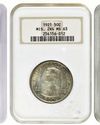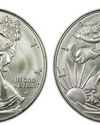
Many people buy bullion items and rare coins from a variety of sources in different places. Some people pay a state sales tax on their purchases and some do not. Why is that?
Years ago, virtually all state sales taxes were paid in person. You went to a store, bought something and if your state collected sales tax and there wasn't an exception to the tax on that item, it was added to your total cost.
Forty-five states and the District of Columbia all impose state sales taxes on some items. There are local municipalities that may also impose an additional sales tax. Five states-Alaska, Delaware, Montana, New Hampshire and Oregon-impose no state sales taxes of any kind on any purchases.
But for coins and bullion items, different rules apply. That is because 38 states look at bullion products and rare coins differently than most other purchased products. Some states take the "enlightened view" that coins and bullion are purchased for investment purposes. So just like when you buy a mutual fund or a common stock, no sales taxes are added to the total.
But to complicate matters, the rules on coin and bullion purchases differ from state to state. Some exclude all bullion purchases but not rare coin purchases. Some charge a different rate on coins and bullion than on other products. Some exclude rare coins and currency but not bullion.
The amount a state may exempt can be based on:
• Your purchase amount: Over certain minimums you may be subject to no sales taxes.
• Some exclude monetized coins, which is actual coinage, but they don't exclude non-monetized items.
• Some states require the purity of the gold or silver to be at certain levels before they exclude anything.
• Some exclude gold and silver but not platinum, palladium or other precious metals. Some only exclude gold or silver.
• Some states exclude any coins that currently have or may have had a legal tender status.
This story is from the December - January 2025 edition of COINage Magazine.
Start your 7-day Magzter GOLD free trial to access thousands of curated premium stories, and 9,000+ magazines and newspapers.
Already a subscriber ? Sign In
This story is from the December - January 2025 edition of COINage Magazine.
Start your 7-day Magzter GOLD free trial to access thousands of curated premium stories, and 9,000+ magazines and newspapers.
Already a subscriber? Sign In

Top 6 Most Popular U.S. Commemorative Coins
During a half-century of researching U.S.commemorative coinage, I have found that these are the top six U.S. commemorative coins favored by collectors, dealers and investors.

GUIDE TO GRADING SILVER AMERICAN EAGLE ONE-OUNCE BULLION COINS
CAC'S MODERN COIN MINT STATE GRADING STANDARDS

TOP Jen U.S. Gold Coins
LIST OF STRONG PRICES AT SPECTACULAR AUCTIONS

$7,500 GOLD BY THE END OF THE DECADE?
\"Gold can easily triple by the end of 2030,\" declares Maurice H. Rosen, the prominent Plainview, New York, gold coin prognosticator and award-winning writer.

PCGS Coin Grading 101
In 1986, the numismatic world changed when Professional Coin Grading Service (PCGS) entered the scene as a third-party certification service to authenticate, grade and encapsulate coins at scale.

HOW TO USE THE COIN VALUES LIST
Coin values are provided beginning with small cents through Double Eagle gold pieces and beyond, and many of the popular modern coins in between, all based on The Insider's Guide to U.S. Coin Values, 21st Edition, by Scott A. Travers (www.usgoldexpert.com) and updated for accuracy.

THEINSIDER'S GUIDE TO U.S. COIN VALUES 23RD EDITION
ULTIMATE LIST OF COIN PRICES

Coin Dealers Attacked, Targets of Organized Crime
Coin dealers nationwide have become the latest victims of organized crime, facing targeted attacks following their attendance at coin shows.

Should You be Paying Sales Tax on Your Bullion and Coin Purchases?
THERE ARE MANY IMPORTANT EXCEPTIONS AND EXEMPTIONS

Physical Format Bitcoin Gains Collector Acceptance
PRICE RECORDS CONFIRM MARKET DEMAND